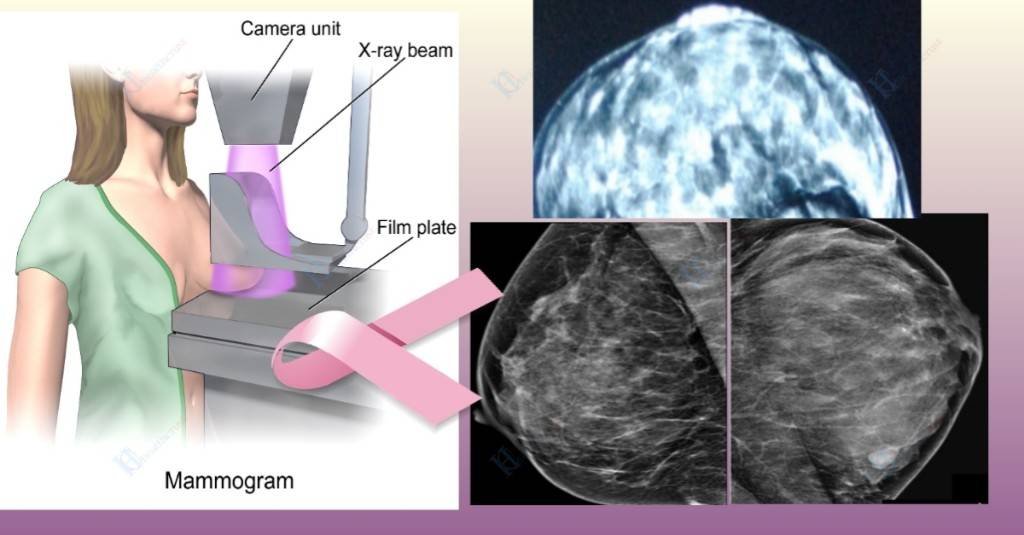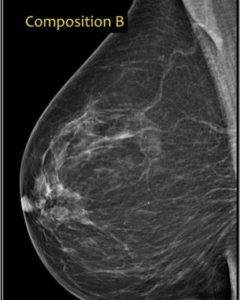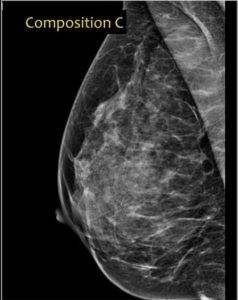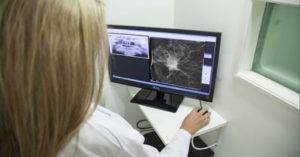
Table of Contents
Mammograms for dense breasts show unique features that make the diagnosis of breast cancers challenging. With dense breasts the chances of errors in mammogram reporting increase as well as the possibility of missing abnormal developments in the breast.
About 50% of all women above the age of 40 are known to have dense breasts as seen in their mammogram results. This is because they have higher amounts of what we call fibrous and glandular tissues (fibroglandular for short) in their breasts in comparison to fatty or adipose tissues.
Breast density is not something static. It changes depending on several factors and this should be good news for some women.
Knowing if you have it at any point in time is important since it could reduce the accuracy of mammogram reports for the detection of breast cancers.
Above all, studies have shown that higher breast density increases your chances of developing breast cancer. The connection between breast density and breast cancer is a question that is yet to be answered.
Dense breasts have no symptoms whatsoever. You can’t find out you have it by merely feeling your breasts Share on X Another good news is that you can find out if you have it through mammograms. Breast density should be part of your mammogram report.
Having dense breasts does not necessarily mean you will have breast cancer. It’s not also a determination of mortality even if you develop the disease. By that I mean you are not more likely to die from breast cancer simply because you have dense breasts than someone who does not.
What are dense breasts?
Three structures lie within the breasts and are primarily responsible for determining if you have a dense breast or otherwise.
They are:
- Fatty or adipose tissues,
- Fibrous tissues, and
- Glandular tissues.
These have specific functions in the breast but for several factors, we’ll discuss later, the composition of the breast with regards to these structures changes over time.
What determines the density of your breasts is the comparative amount of fatty tissues against the combined amount of both the fibrous and glandular tissues, otherwise called fibroglandular tissues.
The more fatty tissues there are in the breast, the less dense and the more fibroglandular tissues there are, the denser.
So, if you are told you have dense breasts, what that means is that you comparatively have more fibroglandular tissues in your breasts than fatty tissues.
People may feel dense breasts are some kind of ailments because of the concerns they raise in connection to a higher risk of breast cancer. In truth, they are normal and are found in perfectly healthy breasts.
Categories of breast density in a Mammogram.
There are four different categories of breast density. These are:
Cat. A: Predominantly Fatty.

Breasts that fall in this category are known to be almost all fatty. Since fatty tissues are not dense, the mammogram of category A breasts appears uniformly grey with no observable areas of fibroglandular densities. 1 out of every 10 women has breasts that fall in this category. That is, 10% of women have such breasts.
Cat. B: Sparsely spread areas of fibroglandular density.

Here, scattered areas of fibroglandular density exist but the rest of the breast remains predominantly fatty. Approximately 40% of women have breasts that fall into this category which is 4 out of every 10.
Cat. C: Heterogeneously dense Breasts.

This represents another 40% of women’s breasts. A mammogram reveals an even spread of fibroglandular density throughout the breast. This is the point from which we regard a breast as being dense. Small tumors can be missed in a mammogram as a result.
Cat. D: Extremely dense Breasts.

In this category, the level of fibroglandular density is so high that even sizable tumors can be obscured. 1 in every 10 women is known to have breasts that fit into this category.
Every breast whose mammogram places on the first two categories, A and B, is regarded as not dense whereas anyone that falls under categories C and D is regarded to be dense.
The majority of women, about 80%, have breasts that are either of scattered areas of fibroglandular density(Cat. B) or heterogeneously dense(Cat. C)
There was no way I could discuss dense breasts specifically, without showing you images. Therefore I obtained all these images from “Radiology Assistant”, of the Netherlands and I am grateful.
They were very thorough on this subject and included an exciting approach I liked, in distinguishing the categories mentioned above.
Category. A: Less than 25% Fibroglandular.
Category. B: 25-50% Fibroglandular.
Category. C: 50 -75% Fibroglandular.
Category. D: greater than 75% Fibroglandular.
This might be old but interesting. Conclusively, as long as your breast consists of less than 50% of fibroglandular tissues, you don’t have dense breasts.
It’s not uncommon for two different radiologists to classify the same mammogram differently. One could infer category B whereas another feels it is category C. The classification is now being automated to ensure uniformity in reporting.
However, the bottom line is that even if your mammogram chiefly falls under category B but there are areas in your mammogram that are bright enough to obscure small masses, it is regarded as category C. This means you have dense breasts.
Factors that affect breast density.
- Age: For the majority of women, breast density reduces as they age. Few may see no changes though. Younger women are expected to have higher breast densities on average.
- Low body mass index (BMI): BMI is the ratio of your body weight(kg) divided by the square of your height, in meters. If yours is low, it should not come as a surprise for your mammogram to show you have dense breasts.
- Genetics: There is a familial disposition associated with breast density. In other words, it’s often inherited according to the National Cancer Institute and this represents the most significant factor that determines breast density.
- Vitamin D and Calcium intake: The American Association of Cancer Research (AACR) carried out a study that showed Vitamin D and calcium intake from foods and food supplements can lower breast density in women below the age of menopause.1 So if you are looking to reduce your breast density, this is a sure, risk-free way to achieve that If you decide to give it a try, I would appreciate it if you inform me about the outcome as I am also a researcher with diverse interests.
- Post-menopausal hormone replacement therapy: This leads to an increase in breast density.
- It is believed that pregnancy and breastfeeding are associated with mammographic changes indicating higher breast densities but this is not necessarily true according to the Journal of Academy of Radiology.2
- Some drugs used in the treatment and prevention of breast cancer could lower breast density.
Mammogram for dense breasts.
The traditional mammogram is something usually produced in films but this has its limitations. Women with dense breasts make up half of the population of those who show up for mammograms annually.
Apart from the fact they are at a slightly higher risk of breast cancer, there is also a higher possibility of missing out on tumors in mammogram screening.
Knowing if your breasts are dense or not is something your doctors are mandated to tell you after your mammography. This will enable you to make decisions on supplemental screening choices available to you if necessary.
Best mammogram for dense breasts:
With advances in disease diagnosis and prevention, we have seen a gradual shift from film mammograms to digital.
The 3-dimensional digital tomosynthesis has greatly improved diagnostic efficiency in the detection of abnormalities in the breasts particularly for women with high breast density. It gives better images beyond areas of breast density in mammograms.
Whether you are a lady with gorgeously large or cute small dense breasts, the same principles and procedures apply across the board.
Be informed that increased breast cancer risks associated with breast density should not be a reason to opt for supplemental screenings except where other risk factors place you in the group of high-risk individuals.
3-D mammograms, however, come at extra costs which may not be covered by insurance. This is something you will need to find out.
There are women with dense breasts who meet the criteria of being considered to be at high risk of breast cancer following other risk factors like genetic mutation.
Research has shown that breast ultrasounds or MRIs in addition to mammogram screening will enhance their chances of not missing out on even small tumors.
The problem with these supplemental screenings is that they have higher chances of giving false-positive results in comparison to mamograms. This leads to avoidable and unnecessary biopsies.
According to the American Cancer Society (ACS), there is no consensus on what supplemental tests should be carried out alongside your regular mammogram.
Mammogram options for dense breasts.
Latest advances in the diagnosis of breast cancer which women with dense breasts can still benefit from Include:
- Contrast-enhanced mammography(CEM). CEM, according to the Radiological Society of North America, is regular mammography except it involves the use of contrast mediums(the type used in Computed Tomography scans) to create contrast-material-enhanced images of the breast.3 It is a great alternative to both breast Ultrasound and MRI which have themselves had their upgrades.
- The Automated whole breast ultrasound( ABUS).4 This is designed for women with dense breasts and implants. It produces 3-D images that can be stored for long-term monitoring.
- Abbreviated Breast MRI(AB-MRI). This is faster and cheaper than the traditional MRI with research-proven benefits for women with dense breasts, according to the British Institute of Radiology (BIR).5
The above-listed three items are largely still being researched. Meanwhile, your 3-D mammogram is awesome if you have dense breasts. Ultrasound and MRI are usually employed in conjunction with mammograms and not as replacements for them.
References.
- Bérubé, S., Diorio, C., Mâsse, B., Hébert-Croteau, N., Byrne, C., Côté, G., … & Brisson, J. (2005). Vitamin D and calcium intakes from food or supplements and mammographic breast density. Cancer Epidemiology Biomarkers & Prevention, 14(7), 1653-1659. ↩︎
- Swinford, A. E., Adler, D. D., & Garver, K. A. (1998). Mammographic appearance of the breasts during pregnancy and lactation: False assumptions. Academic Radiology, 5(7), 467-472. https://doi.org/10.1016/S1076-6332(98)80186-4 ↩︎
- Kimeya F. Ghaderi, Jordana Phillips, Hannah Perry, Parisa Lotfi, Tejas S. Mehta. (2019). Contrast-enhanced Mammography: Current Applications and Future Directions. Radiological Society of North America. Vol. 39, No. 7. https://doi.org/10.1148/rg.2019190079 ↩︎
- Kelly, K. M., & Richwald, G. A. (2011). Automated Whole-Breast Ultrasound: Advancing the Performance of Breast Cancer Screening. Seminars in Ultrasound, CT and MRI, 32(4), 273-280. https://doi.org/10.1053/j.sult.2011.02.004 ↩︎
- Christiane K Kuhl.(2017). Abbreviated breast MRI for screening women with dense breast: the EA1141 trial. The British Institute of Radiology. Vol. 91, No. 1090. https://doi.org/10.1259/bjr.20170441 ↩︎































































































































































There are really good quality articles on this web site, saved to my bookmarks.